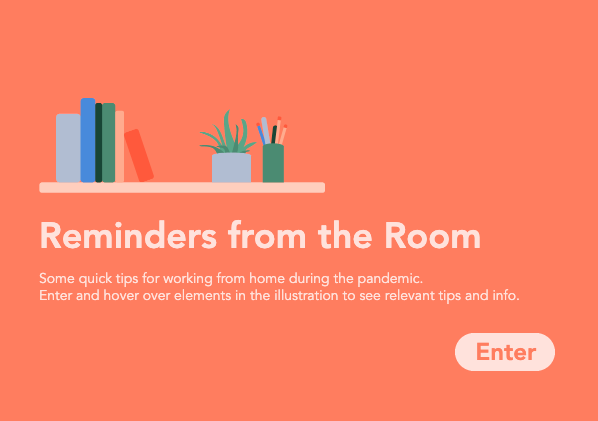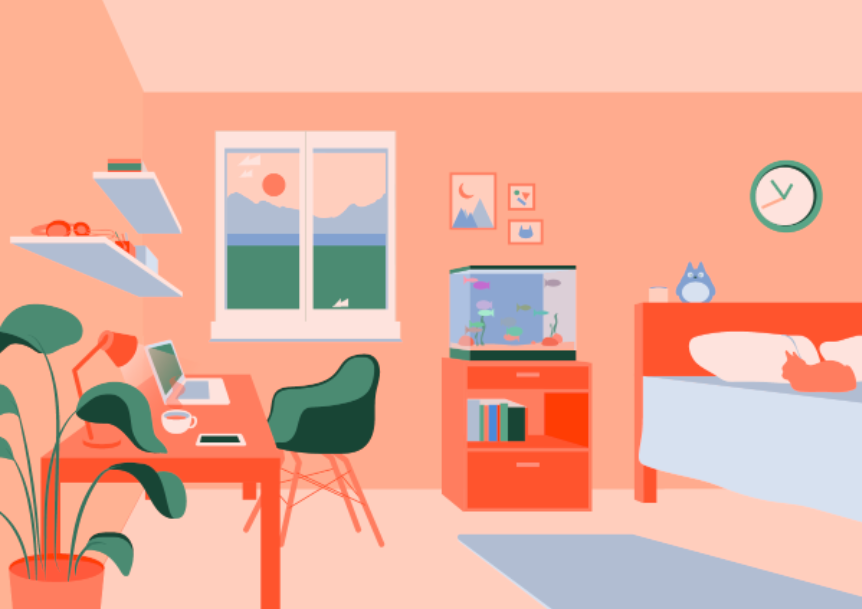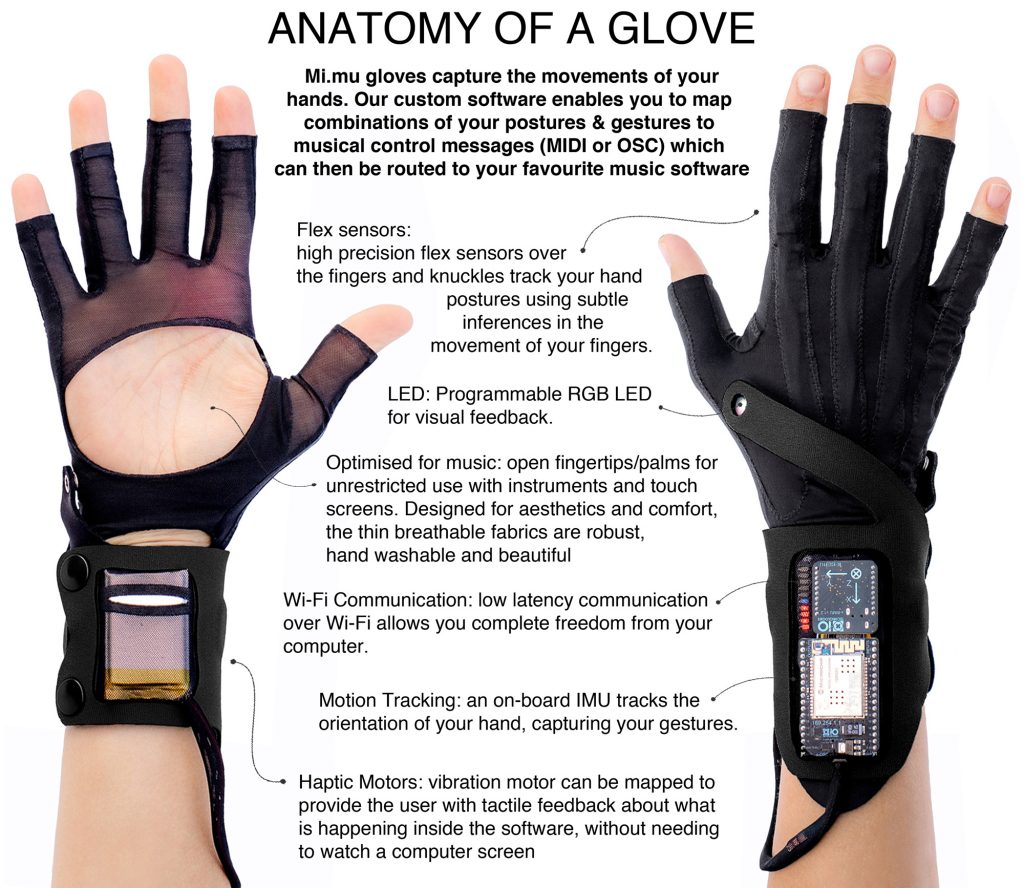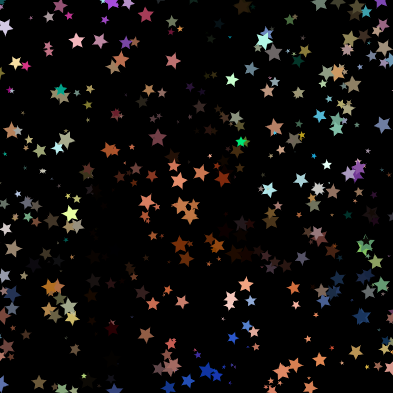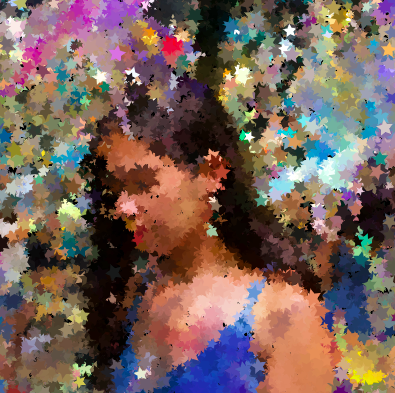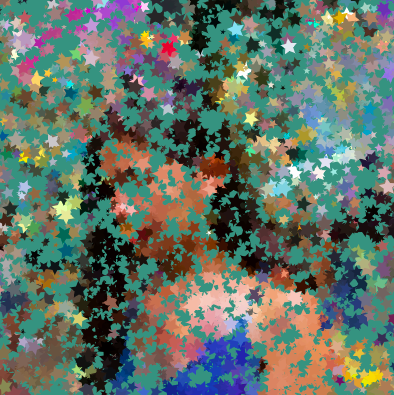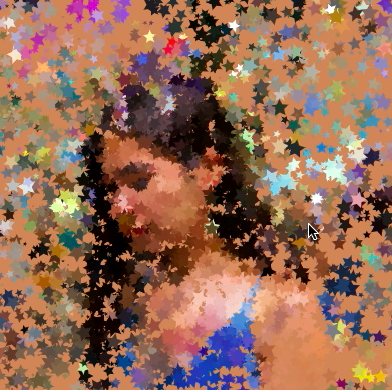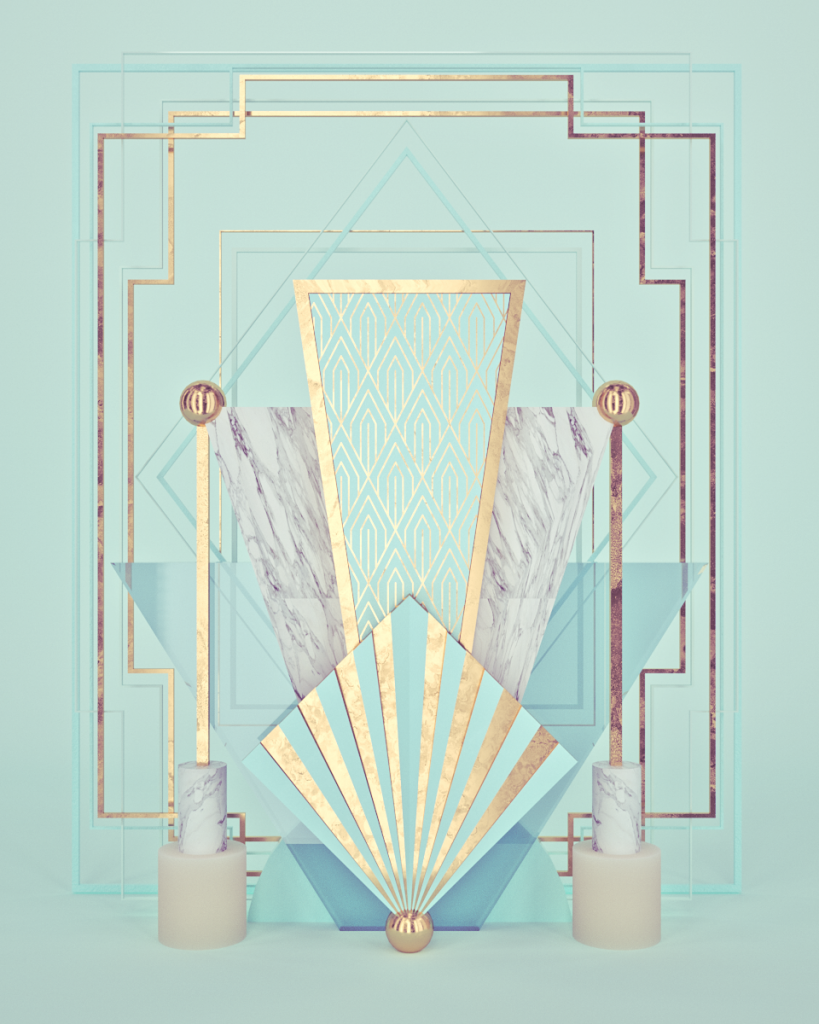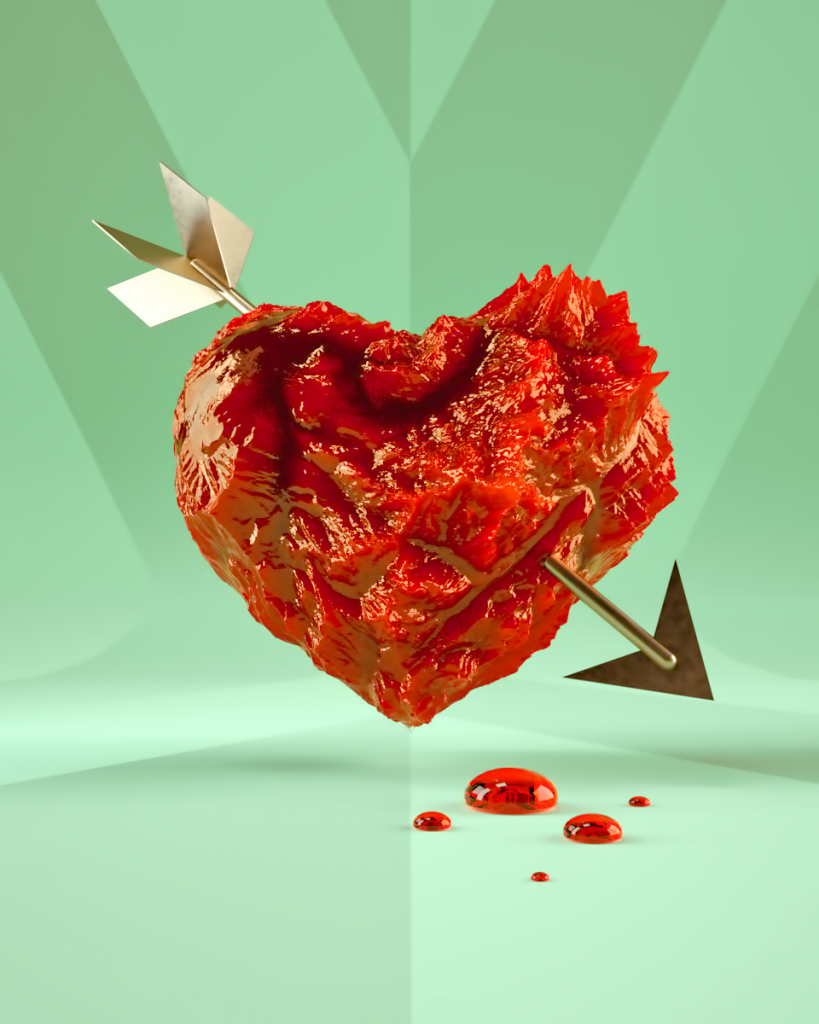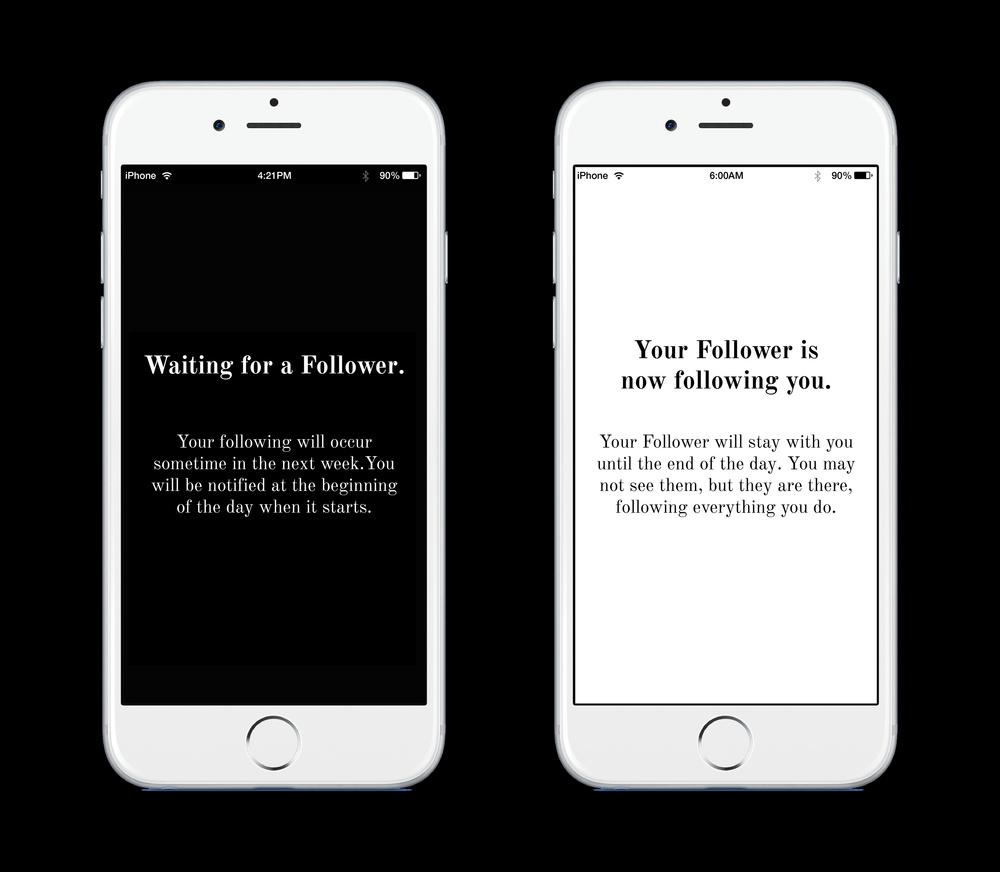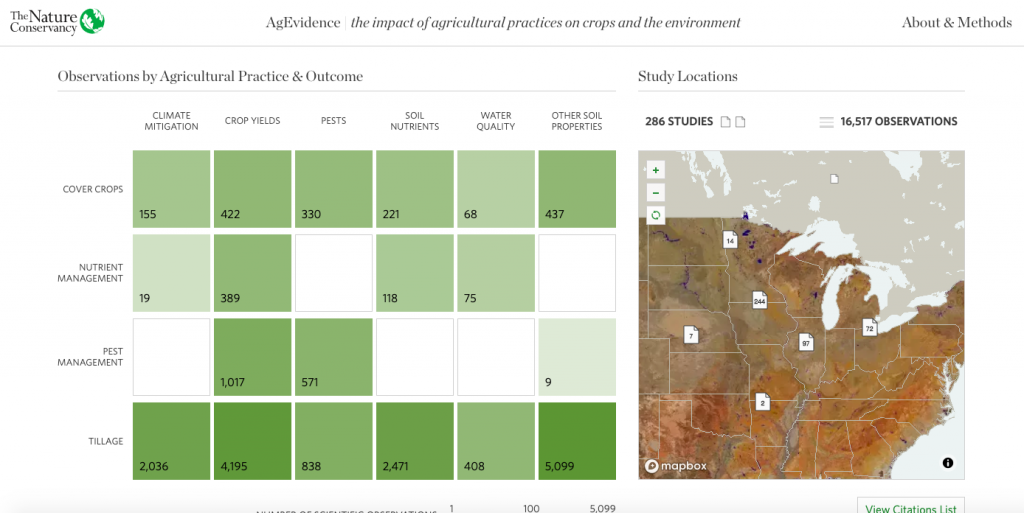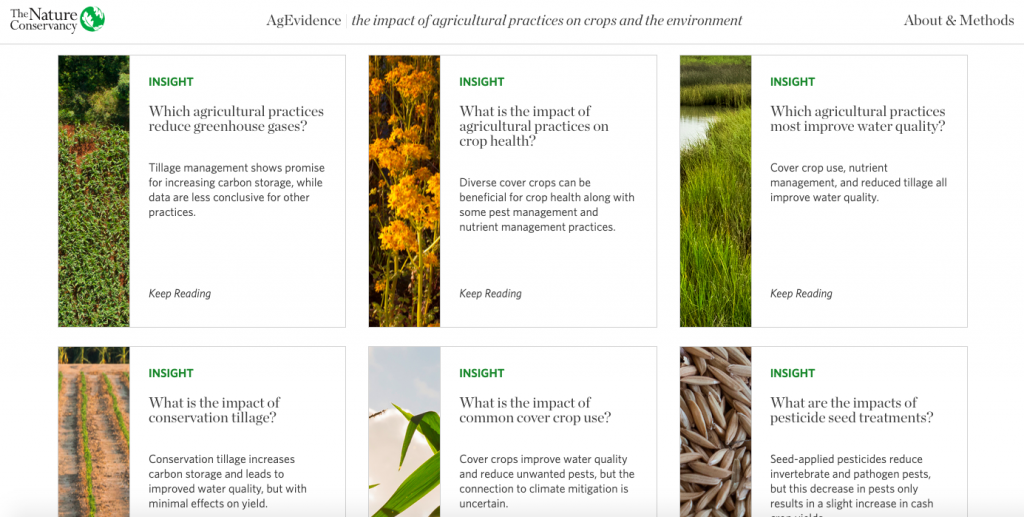//Caitlyn Baensch
//cbaensch@andrew.cmu.edu
//Section D
var shelf;
var bedroom;
var wind;
var steam;
var birds = [];
var fish = [];
var enter = false;
var phoneon = false;
var fadeg = 140;
var fadeb = 150;
var steamy = 266;
var steamdy = .5;
//load illustrations
function preload() {
shelf = loadImage("https://i.imgur.com/FCmktLo.png");
bedroom = loadImage("https://i.imgur.com/WVYB6XA.png");
wind = loadImage("https://i.imgur.com/qjTV5Rs.png");
steam = loadImage("https://i.imgur.com/k561c6E.png");
}
function setup() {
createCanvas(600, 425);
//setup for birds
for(var i = 0; i < 6; i++) {
birdsx = random(width);
birds[i] = makeBirds(birdsx);
}
//setup for fish
for (var i = 0; i < 12; i++) {
fishx = random(325, 385);
fish[i] = makeFish(fishx);
}
frameRate(12);
angleMode(DEGREES);
}
function draw() {
background(0);
//show intro screen with instructions
intro();
//show the room when enter button is clicked
if(enter == true) {
room();
}
}
//birds helper functions
//update the bird positions and display them
function displayBirds() {
for (var i = 0; i < birds.length; i++) {
birds[i].move();
birds[i].draw();
}
}
//remove birds that are off the canvas from the array
function removeBirds() {
var birdsToKeep = [];
for (var i = 0; i < birds.length; i++) {
if (birds[i].x + birds[i].w > 0) {
birdsToKeep.push(birds[i]);
}
}
birds = birdsToKeep;
}
//with a small probability, add a new bird to end of the array
function addNewBirds() {
var newBirdLikelihood = 0.12;
if (random(0,1) < newBirdLikelihood) {
birds.push(makeBirds(width+20));
}
}
function moveBird() {
this.x += this.speed;
}
function drawBird() {
push();
translate(this.x, this.y);
fill(249, 228, 222);
noStroke();
triangle(0, 0, this.w, -this.h, this.w, 0);
triangle(0, 0, this.w/2, -this.h, this.w/2, 0);
pop();
}
//bird constructor (random location, size, and speed)
function makeBirds(birdsx) {
var b = {x: birdsx, y: random(height),
w: random(8, 16), h: random(4, 8),
speed: random(-5, -10),
move: moveBird,
draw: drawBird
}
return b;
}
//fish helper functions
function displayFish() {
for (var i=0; i<fish.length; i++) {
fish[i].move();
fish[i].draw();
}
}
function moveFish() {
this.x += this.dx;
if (this.x > 385 || this.x < 325) {
this.dx = -this.dx;
}
}
function drawFish() {
noStroke();
fill(this.c);
ellipse(this.x, this.y, this.w, this.h);
if (this.dx < 0) {
triangle(this.x+3, this.y, this.x+6, this.y-3, this.x+6, this.y+3);
} else {
triangle(this.x-3, this.y, this.x-6, this.y-3, this.x-6, this.y+3);
}
}
//fish constructor (random location, size, speed, and color)
function makeFish(fishx) {
var f = {x: fishx, y: random(195, 240),
w: random(8, 12), h: random(3, 7),
dx: random(-3, 3),
c: color(random(100, 255), random(100, 255), random(100, 255)),
move: moveFish,
draw: drawFish
}
return f;
}
//wall clock function
function clock() {
var hr = hour();
var mn = minute();
var sc = second();
//second hand
strokeWeight(2.15);
var s = map(sc, 0, 60, 0, 360);
push();
rotate(s);
stroke(255, 176, 148);
line(0, 0, 16, 0);
pop();
//minute hand
var m = map(mn, 0, 60, 0, 360);
push();
rotate(m);
stroke(110, 160, 133);
line(0, 0, 14, 0);
pop();
//hour hand
var h = map(hr % 12, 0, 12, 0, 360);
push();
rotate(h);
stroke(110, 160, 133);
line(0, 0, 10, 0);
pop();
}
//interactions for tip screens helper functions
//headphones: listen to music
function headphones() {
if (mouseX > 22 & mouseX < 80 && mouseY > 150 && mouseY < 170) {
tip('Listen to your favorite music.', 'Listening to music can help you focus, feel better, and relax.');
}
}
//journals: reflect
function journals() {
if (mouseX > 73 & mouseX < 102 && mouseY > 110 && mouseY < 122) {
tip('Reflect on how you are feeling.', 'Try keeping a journal or taking some time each day to check in with yourself.');
}
}
//tea: stay hydrated
function tea() {
if (mouseX > 113 & mouseX < 134 && mouseY > 287 && mouseY < 308) {
tip('Stay hydrated with water or a cup of hot tea.', 'Being well-hydrated improves sleep quality, cognition, and mood.');
}
}
//phone: check in with friends
function phone() {
if (mouseX > 137 & mouseX < 171 && mouseY > 303 && mouseY < 312) {
tip('Check in with friends and family.', 'Catch up over text or phone call and see how everyone is doing.');
}
}
//window: go for a walk
function win() {
if (mouseX > 158.5 & mouseX < 268.5 && mouseY > 107 && mouseY < 217) {
tip('Go outside for a 10-minute walk.', 'A walk can improve your mood and cognitive function as well as reduce stress.');
}
}
//fish tank and cat: spend time with pets
function pets() {
if ((mouseX > 313 & mouseX < 401 && mouseY > 187 && mouseY < 251) || (mouseX > 543 && mouseX < 594 && mouseY > 245 && mouseY < 274)) {
tip('Spend time with pets.', 'Some quality time with your animal friends is sure to make you smile.');
}
}
//books: read a book
function books() {
if (mouseX > 325 & mouseX < 367 && mouseY > 278 && mouseY < 308) {
tip('Get lost in a book.', 'Reading is the perfect way to unwind. Try it before bed instead of using your phone.');
}
}
//yoga mat: stretch
function yoga() {
if (mouseX > 318 & mouseX < 600 && mouseY > 378 && mouseY < 425) {
tip('Take a break and stretch.', 'Doing yoga can help break up long periods of sitting at a desk and clear your mind.');
}
}
//decorations: surround yourself with things that make you happy
function decoration() {
if ((mouseX > 314 & mouseX < 378 && mouseY > 122 && mouseY < 174) || (mouseX > 468 && mouseX < 496 && mouseY > 182 && mouseY < 212)) {
tip('Surround yourself with things you love.', 'Decorate your space with photos, art, and other meaningful items. Avoid clutter!');
}
}
//clock: keep a daily routine
function time() {
if (mouseX > 521 & mouseX < 572 && mouseY > 112 && mouseY < 163) {
tip('Keep a daily routine.', 'Having a daily routine can reduce anxiety and create rhythm in your day.');
}
}
//text formatting for headers
function header() {
textSize(24);
textStyle(BOLD);
textFont('Avenir');
}
//text formatting for body
function body() {
textSize(14);
textStyle(NORMAL);
textFont('Avenir');
}
//tip screens formatting
function tip(line1, line2) {
background(250, 227, 221, 230);
fill(237, 122, 93);
header();
text(line1, 40, 250);
body();
text(line2, 40, 285);
}
//intro opening screen with title and instructions
function intro() {
background(255, 136, 108);
fill(250, 227, 221);
image(shelf, 40, 100, 286, 95);
textSize(36);
textStyle(BOLD);
textFont('Avenir');
text('Reminders from the Room', 40, 250);
body();
text('Some quick tips for working from home during the pandemic.', 40, 285);
text('Enter and hover over elements in the illustration to see relevant tips and info.', 40, 302);
noStroke();
fill(250, 227, 221);
rect(456, 335, 100, 38, 38);
fill(255, 136, 108);
header();
text('Enter', 476.5, 362);
//if enter button is hovered over
if (mouseX > 456 & mouseX < 555 && mouseY > 335 && mouseY < 373) {
fill(244, 181, 161);
rect(456, 335, 100, 38, 38);
fill(237, 122, 93);
header();
text('Enter', 476.5, 362);
}
}
//if enter button is pressed, enter the room
function mousePressed() {
if (mouseX > 456 & mouseX < 555 && mouseY > 335 && mouseY < 373) {
enter = true;
room();
}
}
//room environment
function room() {
//landscape outside window
image(wind, 146, 100, 125, 116);
//birds flying outside window
displayBirds();
removeBirds();
addNewBirds();
//bedroom
image(bedroom, 0, 0, width, height);
//fish swimming in fish tank
push();
displayFish();
fill(178, 190, 209, 50);
rect(326, 187, 74, 56);
pop();
//wall clock by bed ticking
push();
translate(545, 138);
rotate(-90);
clock();
pop();
//phone screen new notifications
push();
noStroke();
fill(37, 66, 52);
quad(140, 303.5, 165, 303.5, 167, 308, 139, 308);
if (frameCount % 90 == 0) {
phoneon = true;
if (phoneon == true) {
fadeg = 240;
fadeb = 240;
fill(249, fadeg, fadeb);
quad(140, 303.5, 165, 303.5, 167, 308, 139, 308);
}
} else {
if (fadeg >= 140 & fadeb >= 150) {
fadeg = fadeg - 3;
fadeb = fadeb - 3;
fill(249, fadeg, fadeb);
quad(140, 303.5, 165, 303.5, 167, 308, 139, 308);
phoneon = false;
}
}
pop();
//steam floats up over cup of tea
image(steam, 115, steamy, 14, 24);
steamy -= steamdy;
if (steamy <= 257 || steamy > 267) {
steamdy = -steamdy;
}
//show tip screens for user interaction
headphones();
journals();
tea();
phone();
win();
pets();
books();
yoga();
decoration();
time();
}For my final project, I made an interactive illustration featuring tips for working from home during the pandemic. With hours spent locked up inside in endless Zoom meetings, I think that Zoom fatigue, a warped sense of time, and feelings of stress and anxiety are all common sentiments. I want to bring awareness to these challenges and offer simple strategies to combat fatigue and stress. I wanted my program to have a relaxing and calming feeling to it, so I chose a light, playful color palette for my illustrations as well as used an inviting typeface.
To interact with my program, follow the instructions on the intro screen. Click the “Enter” button to enter the room and explore the environment. Hover over different elements in the animated illustration to view relevant tips and information.
If I had more time, I might consider adding sound to some of the elements in the room. I would also maybe think about adding illustrations/animations to the advice screens and using p5.js to create patterns on objects or wallpaper.
![[OLD FALL 2020] 15-104 • Introduction to Computing for Creative Practice](../../wp-content/uploads/2021/09/stop-banner.png)
